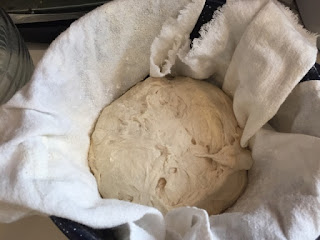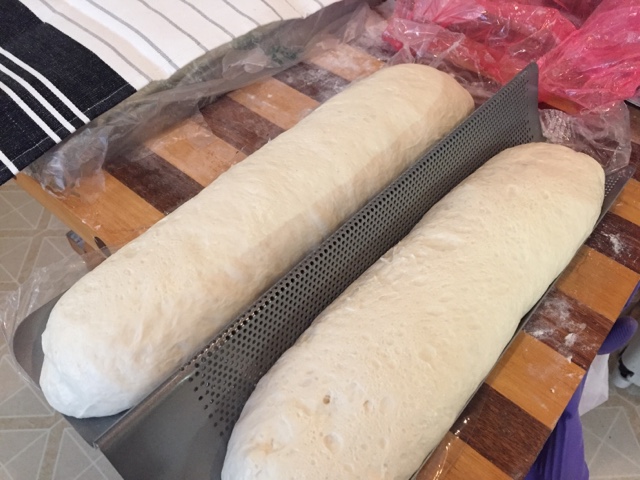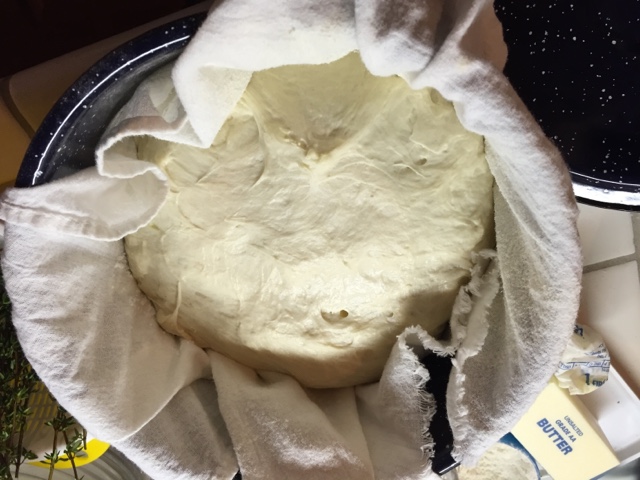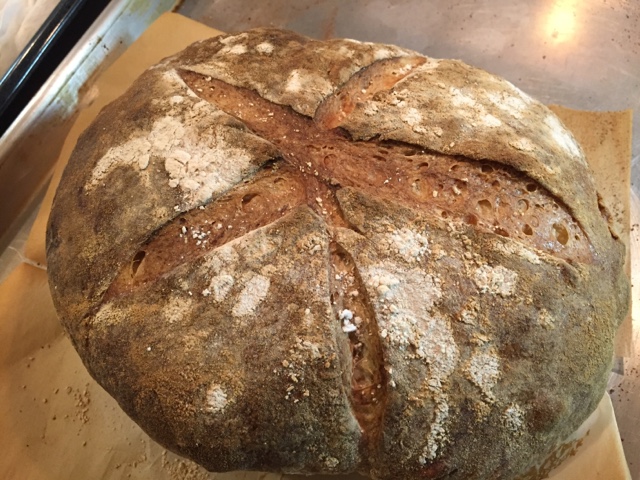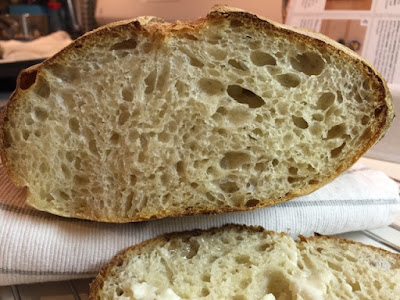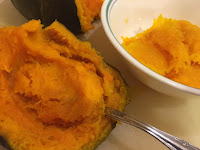It all started with cravings for sandwich made with home baked bread. A bowl of Leaven I tried to make many times during summer proved to me that 'that is not it'. The baked bread's crumb feel wet and heavy. This time around, I followed as close to the formulas as possible by saving only small amount of starter, then adding 50/50 of flour and water, a good pinch of yeast, then mixed thoroughly. Placing the lid and kept in dark spot of kitchen. It went on for a few days. Checking it each day, but all I saw was large bubbles forming. The leaven was failing the float test. Then this week, I thought about my container with lid on vs Tartine's instruction of covering with towel.

Even though there got to be Air during the process I have been keeping the lid on. Why? Because it didn't work out before in summer. My dough turned out taffy like texture and bread turned out tough. The starter did not have any power. . . But let me try again I thought. After a few days, Interesting. I started to notice the 'mini' bubbles forming on the top. I continued to discard most of it, then saved 1/4 C of it and added 50/50 flour and water. I also started another bowl of leaven mixing with flour and some rye and a pinch of yeast. Discarding and feeding the leaven every day. Keeping the lids of both containers loose. Checking it each day. Then I noticed the 'lightness' of the leaven in the jar and bowl.
It passed the floating test. It was very exciting as I have never seen this happened. I decided to feed the the new mix for a few days also. Eventually I added enough feed to make the required weighed amount of Poolish.
200 g Flour
200 g water - at least 75'F
Added them to about 1 C of leaven pre-made, instead of adding dry yeast.
Weigh and measure total of 400 g Poolish mixture after mixing the ingredients.
Cover loosely and Set aside - overnight in 'cold' kitchen
Do the float test. Ready? Good. No? Then let it stand longer.
Prepare Leaven: Mix 1 Tbsp of Mature Starter/Leaven that you pre-made with 220 g Flour, 220 g Water (80'F). Cover and let stand. Do the float test.
Measure 400 g of leaven into a large bowl. Keep the remaining 40 g for future starter. Pour 500 g warm water (74'F to 76'F) into leaven and add Poolish. Stir to disperse the ingredients.
Add 650 g A-P Flour and 350 g Bread Flour. Mix with hands or large wooden spoon.
The dough is heavy and rough looking. Transfer to heavy/thick clear plastic container and begin the bulk fermentation.
Cover loosely with lid and towels to keep warm. Rest for 40 min (in cold kitchen). Measure 25 g kosher salt and 20 g warm water.
Start the first turn of Four turns - at first turn - Open the lid and add salt, wet your hand (from 20 g water) pull dough from bottom and over to the top, repeat each corner. Salt will be roughly mixed in.
Repeat the turn one or more times if your hands are small like mine. You will still feel the salt granules here and there, but eventually the salt will get mixed in at each subsequent turn.
Cover and rest 40 min.
At each turn of the dough, the dough will increase in volume and feel pliable and lighter.
(This dough looks much more structured than the Sourdough I in previous post. The formula is different also .)
Portioning:
After the fourth turns (or 'your' estimated visual turns), transfer the dough to a work surface without flour. Divide the dough into portions measuring the approximate length size of the Baguette doughs your oven could hold. I divided dough to be prepared to be shaped into three baguettes, two French Breads, and one Rondo. Form the doughs into rectangular shape with rounded corners. If you notice the dough starts to spread then give each dough a several tucking turns. Resting the dough in between each turn and tuck. Once the dough can hold its shape form them into rectangular shape.
Cover and rest for 30 min.
Preheat oven to 500'F. For 15 min steam required for best result for crispy crust, set a roasting pan filled with water at the base of oven with towel in it to build steam. Make sure the pan you use is deep enough to hold hot water to last at least 15 minutes. I use my oven's roaster/grill pan that came with it.
I used French Bread and Baguette molds for my final rise and shaping.
A soon as the oven reaches 500'F, place the bread mold on third rack from the top - quickly. Spray as you quickly close the oven door.
Immediately lower the temp to 475'F. Bake for 18 min and check the color of the dough. Every 5 min, Crack open oven door and quickly Spray aiming at the walls of interior oven, if your steam pan doesn't seem to be building enough steam power. At the end of 18 minutes, check and make sure the dough is fully browned before taking them out. Bake a few minutes longer to make sure the crust is browned thoroughly, if needed.
Remove steamer pan after 15 min and or remove the towel in the pan that is set in it before it starts to scorch to cause unpleasant odor to the bread.
Rondo's dough is rising in flour-coated flour cloth with seam side up.
I should have dusted off the rice flour for this one before baking.
I am very happy with the results, however.
Both Baguettes and Rondo turned out with great holes.
See the differences of bread baked in well steamed oven vs lacking of it? Baking in the well steamed oven produced shiny crusts. While the Rondo was covered with flour/rice flour before the baking, it contributed to dull looking crust. As for the taste of these sourdough breads, they are excellent. I love it better than the store bought. Crumbs are soft and light with crispy crust. 















